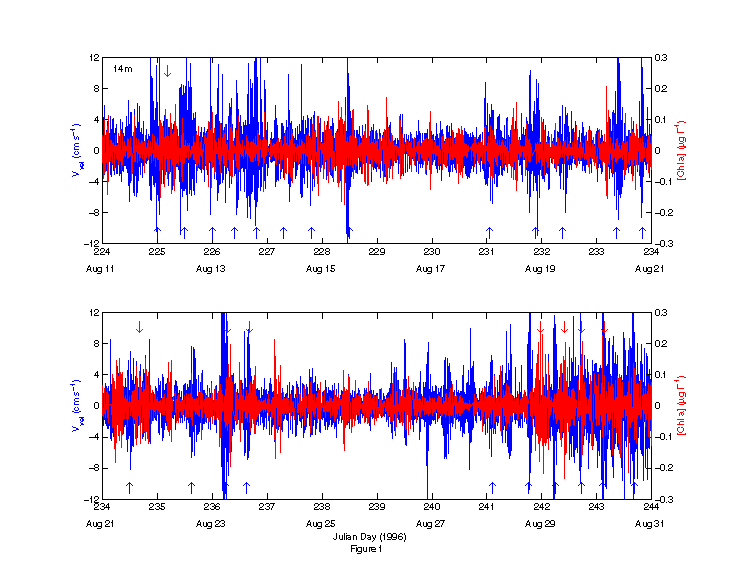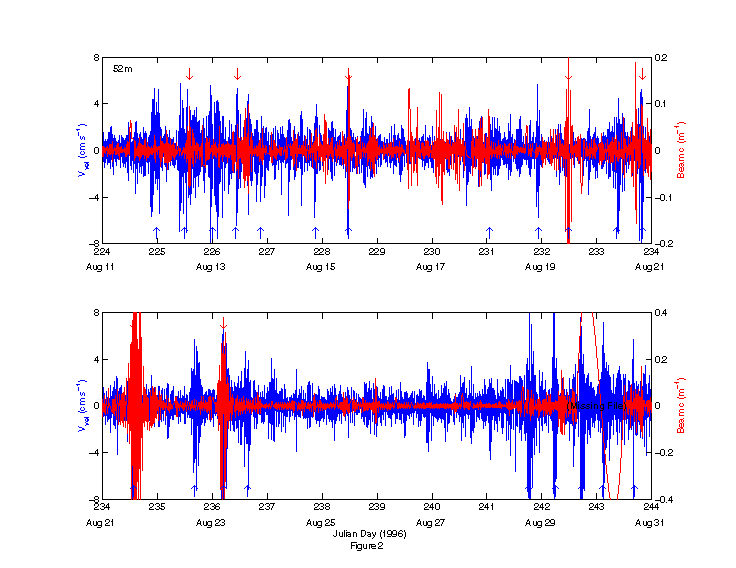
G. C. Chang and T. D. Dickey
Ocean Physics Laboratory, University of California at Santa Barbara,
6487 Calle Real Unit A, Goleta, CA 93117; e-mail: grace@icess.ucsb.edu
Abstract. Observations of internal solitary waves (ISWs) were obtained on a continental shelf during the Coastal Mixing and Optics (CMO) experiment. High-frequency, high-energy bursts were seen in north-component current data and temperature data, as well as in chlorophyll a concentration and beam c data. ISWs resulted in vertical pumping of biogenic and non-biogenic material, as observed in the optical data. Tidal phase and direction, and strength of stratification have a direct influence on the formation and characteristics of ISWs.
Introduction
Observations of high-energy, large-amplitude solitary waves on continental shelves are common (e.g., Sandstrom et al. [1989]). The interaction of tides with the continental shelf edge during periods of stratification leads to the formation of internal tides. These internal tides are modified over time into non-linear, high-energy bursts, called internal solitary waves (ISWs), or solitons. ISWs are important to vertical transport and mixing of biogenic and non-biogenic components in the water column [Weidemann et al., 1996]. These high-energy bursts bring nutrients and phytoplankton into or out of the euphotic layer, resulting in blooms or death. ISWs also resuspend sediment from the ocean bottom [Bogucki et al., 1997].
Methods
The site of the Coastal Mixing and Optics (CMO) experiment was the "Mud Patch" of the Mid-Atlantic Bight (MAB) continental shelf. We collected high temporal resolution time-series of physical and optical data at four depths (14, 37, 52, and 68 m) using instruments on bio-optical systems (BIOPS) [Chang et al., 1997] on a mooring and a tripod. BIOPS instruments used in this study include: 1) PAR sensors, 2) stimulated fluorometers, 3) temperature sensors, and 4) beam transmissometers (660 nm). The sampling rate was eight times per hour. This paper focuses on observations obtained during our fall 1996 CMO mooring deployment between Julian Day (JD) 224 and 244 (August 11 and 31).
Oregon State University (OSU) scientists deployed several physical instruments
on a subsurface mooring [Boyd et al., 1997]. An uplooking RD Instruments
Acoustic Doppler Current Profiler (ADCP) at 65 m, and temperature and salinity
sensors at several depths were used in this study. ADCP current data were
obtained every two minutes between 3 and 55 m with 4 m bins. Brunt Vaisala
frequency (N^2(z), expressed in s^-2) was calculated between depths where
subsurface mooring temperature data were available. All data used in this
study were band-pass filtered between 10 minutes and one hour to highlight
high-frequency ISWs.
Observations
Solitary waves were not uncommon on the MAB continental shelf during the CMO experiment. ISWs were observed in band-passed filtered north-component current data (Figures 1 and 2) and temperature data (data not shown) as high-frequency bursts. The waves passed through the mooring site at a frequency similar to the semi-diurnal tides. The highest amplitude solitons occurred at depths of 20 and 50 m, which were the depths of highest stratification (seen in the N^2 data; not shown). Stratification increased between JD 241 and 244; the frequency and amplitude of ISWs also increased over the same time period (Figures 1 and 2).
Oscillations in band-pass filtered chlorophyll a concentration ([Chl a], expressed in mg l^-1) at 14 m were at times correlated with ISWs seen in the 15 m velocity data with a 2.5 to 5 hour time lag (Figure 1). It appears that the ISWs passing at 20 m may have pumped nutrients up from below the euphotic layer (~25 m) to depths were phytoplankton were able to utilize them, as well as moved phytoplankton to depths below the euphotic layer.

In addition, bursts in the beam c data at 52 m were at times correlated
with ISWs seen in the 51 m velocity data (Figure 2). No time lag was found
between beam c and current bursts. Increases in beam c at deep depths in
the water column are generally attributed to sediment resuspension. Interestingly,
during periods of beam c bursts at 52 m, the 68 m beam c values did not
increase from mean conditions. One hypothesis for this is that the ISW
amplitudes were not high enough to resuspend sediment from the ocean bottom,
but rather, the solitons pumped sediment from the upper part of the nephloid
layer. Another hypothesis is that the sediment resuspension caused by the
ISWs was not significant to the background beam c values at 68 m. Also,
it is possible that the increases in beam c were the result of sinking
biogenic particles from above.

Figure 2. Time-series of band-passed filtered north-component velocity
(blue) measured at 51 m and beam c (red) measured at 52 m. The arrows represent
times where internal solitary waves were observed.
Conclusions
Internal solitary waves were observed in high temporal resolution physical and optical data collected on a continental shelf during the CMO experiment. Optical data were not always correlated with high-frequency ISW packets seen in current data. The phase and direction of the semi-diurnal tides onto the continental shelf edge have a direct influence on the characteristics of ISWs. In addition, soliton formation depends on the strength of stratification in the water column. Biological processes associated with ISWs (blooms, death, etc.) are dependent on the euphotic layer depth, nutrient availability, mixing rate, etc.
Acknowledgements. This work was supported by the Office of Naval Research as part of the Coastal Mixing and Optics program. We would also like to thank Murray Levine and Tim Boyd (OSU); Derek Manov and David Sigurdson for their engineering and technical support; and Joe McNeil for his help in statistical analyses.
References
Boyd, T., M.D. Levine, and S.R. Grad, Mooring observations from the Mid-Atlantic Bight, OSU 97-2-164, 226 pp., Oregon State Univ., Corvallis, OR, 1997.
Bogucki, D., T. Dickey, and L. G. Redekopp, Sediment resuspension and mixing by resonantly generated internal solitary waves, J. Phys. Oceanogr., 27, 1181-1196, 1997.
Chang, G.C., T.D. Dickey, D.V. Manov, D.E. Sigurdson, and J.D. McNeil, Data report: Coastal Mixing and Optics Deployment I, OPL-4-97, 44 pp., Ocean Physics Laboratory, Univ. of Calif., Santa Barbara, CA, 1997.
Sandstrom, H., J. A. Elliott, and N. A. Cochrane, Observing groups of solitary internal waves and turbulence with BATFISH and echo-sounder, J. Phys. Oceanogr., 19, 987-997, 1989.
Weidemann, A. D., W. S. Pegau, L. A. Jugan, and T. E. Bowers, Tidal influences on optical variability in shallow water, Ocean Optics, 2963, 320-325, 1996.